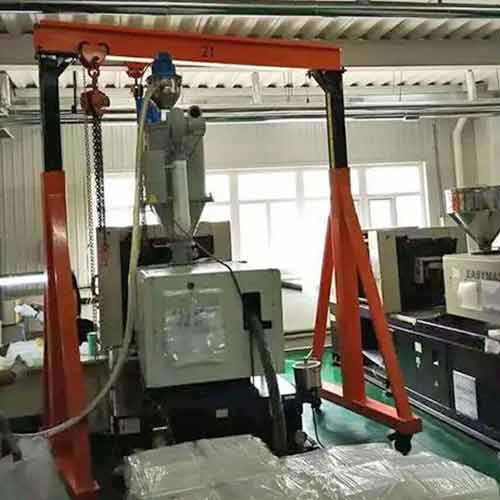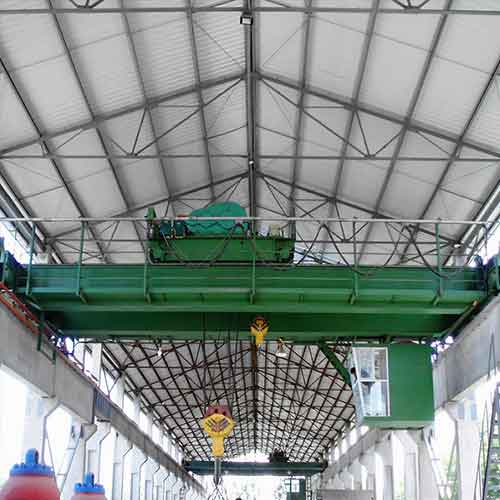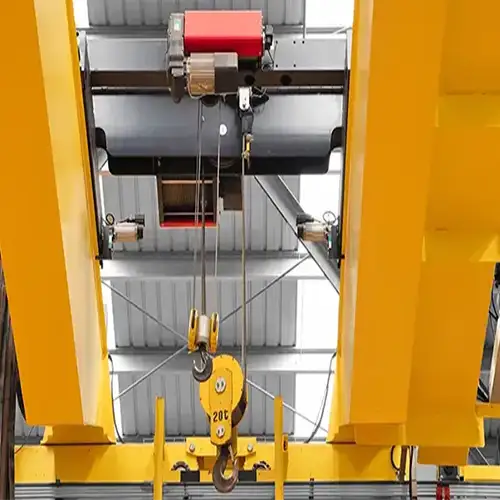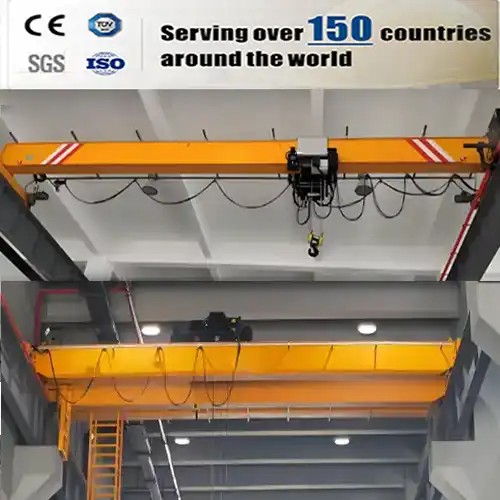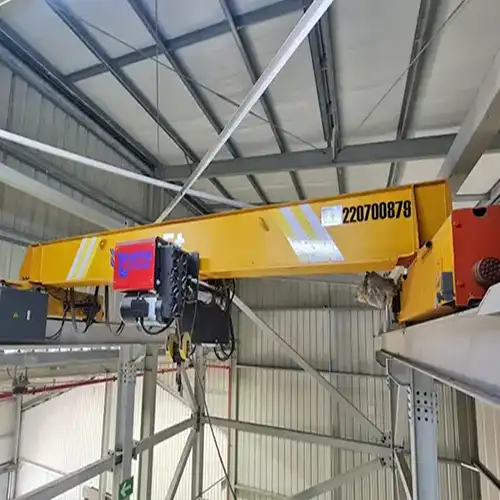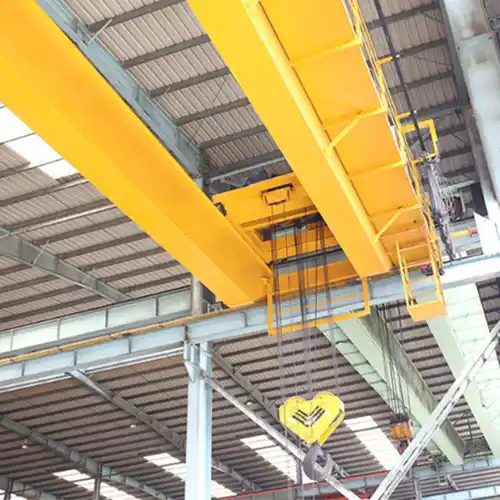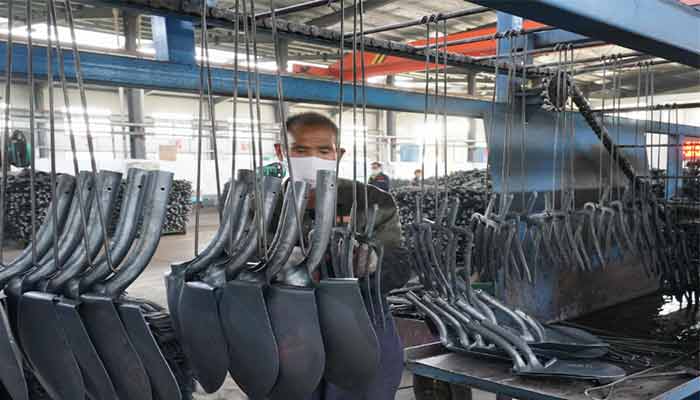
Overhead Cranes for Hardware Parts Manufacturing 5 Ton 10 Ton
The manufacturing of hardware parts is a meticulous and precise endeavor, where efficiency and accuracy are paramount. Within this industry, the role of overhead cranes is nothing short of indispensable. These towering machines are the unsung heroes that silently orchestrate the seamless flow of materials and components, ensuring the gears of production never stop turning.
From the humble fastener to complex machinery components, overhead cranes play a pivotal role in the creation of hardware parts. By effortlessly lifting, positioning, and transporting loads, they are the unswerving workforce behind the scenes, making it all possible. In this comprehensive guide, we will delve into the world of overhead cranes and their pivotal role in optimizing hardware parts manufacturing.
Types of Overhead Cranes for Hardware Parts Manufacturing
In the intricate world of hardware parts manufacturing, the selection of the right tools is paramount to success. Among these tools, overhead cranes stand tall as versatile workhorses, each tailored to specific tasks and environments. In this chapter, we will explore the diverse array of overhead crane types commonly found in hardware parts manufacturing and delve into their unique features and benefits.
Imagine a manufacturing facility as a grand orchestra, with each section contributing its unique melody to the symphony of production. Overhead cranes are the conductors of this orchestra, ensuring that materials and components move harmoniously from one stage to the next.
Within the realm of hardware parts manufacturing, several types of overhead cranes take center stage. Let's meet the players:
Bridge Cranes (Overhead Traveling Cranes):

Single Girder Bridge Crane:This nimble performer boasts a single horizontal beam and is well-suited for lighter loads and smaller workspaces.

Double Girder Bridge Crane:With a double dose of strength, these cranes handle heavier loads and offer greater span widths, making them ideal for larger and more robust hardware parts.
Gantry Cranes:
Gantry cranes are akin to bridge cranes but stand on legs that run along the ground. This versatility allows them to perform outdoors and in areas with irregular floor surfaces, offering the flexibility needed in various hardware parts manufacturing settings.
Specialty Overhead Cranes:
In addition to these standard types, there are specialty overhead cranes designed for specific hardware parts manufacturing processes.
These overhead crane types serve as the instrumental components of the hardware parts manufacturing symphony, each designed to meet the unique demands of various production processes. In the following sections, we will take a closer look at these cranes, uncovering their distinctive features and exploring the benefits they bring to the stage of hardware parts production.
Overhead Crane Selection for Hardware Parts Manufacturing
Selecting the perfect overhead crane for your hardware parts manufacturing process is akin to choosing the ideal tool for a craftsman. The right crane can elevate efficiency, precision, and safety in your production. In this chapter, we embark on a journey to guide you through the process of selecting the ideal overhead crane for your specific hardware parts manufacturing requirements.
The Blueprint for Crane Selection
Choosing the right overhead crane is not a one-size-fits-all endeavor. Hardware parts manufacturing encompasses a broad spectrum of processes, each with its unique demands. Therefore, selecting the appropriate crane begins with a detailed understanding of your manufacturing workflow. Here's a step-by-step guide to help you make an informed choice:
- Evaluate Your Production Needs: - Start by assessing the nature of your hardware parts manufacturing. Determine factors such as load capacity, production volume, and workspace constraints.
- Identify Your Specific Requirements: - Pinpoint the particular functions your crane must perform, such as lifting, transporting, or precise positioning of loads.
- Consider Your Work Environment: - Take into account the environmental conditions where the crane will operate. Is it an indoor or outdoor setting? Are there specific safety or cleanroom requirements?
- Understand Load Characteristics: - Analyze the size, shape, and weight of the loads your crane will handle. This will help in choosing the right crane type and capacity.
- Customization Options: - Overhead cranes can be customized to suit your specific needs. Explore available customization options, such as adding specialized lifting attachments or incorporating automation features.
- Safety and Compliance: - Ensure that your crane choice aligns with safety standards and regulations specific to your hardware parts manufacturing sector.
- Consult with Experts: - Don't hesitate to seek advice from crane manufacturers and experts who can provide insights and recommendations based on your unique requirements.
Customization for Tailored Solutions
The beauty of overhead cranes lies in their adaptability. Depending on your hardware parts manufacturing processes, customization options are available to ensure your crane aligns perfectly with your needs. Customization can include:
- Lifting Attachments:Selecting the right lifting attachment, such as hooks, magnets, or vacuum lifters, can optimize load handling for specific hardware parts.
- Automation:Incorporating automation features, like variable speed controls and remote operation, can enhance efficiency and precision.
- Specialized Safety Features:If your manufacturing process demands exceptional safety measures, customized safety features, such as overload protection or anti-sway systems, can be integrated.
- Environmental Considerations:In cases where cranes operate in challenging environments, customization can include features like corrosion-resistant coatings for outdoor use or cleanliness requirements for cleanroom environments.
Tailoring your overhead crane to your hardware parts manufacturing process is an investment in precision, efficiency, and safety. In the following chapters, we will delve into the real-world applications and benefits of these tailored solutions in hardware parts manufacturing.
Applications of Overhead Cranes in Hardware Parts Manufacturing
The value of overhead cranes in the realm of hardware parts manufacturing becomes most apparent when we look at their real-world applications. These robust machines serve as the backbone of production, facilitating seamless processes, enhancing efficiency, and ensuring the utmost precision. In this chapter, we dive into actual case studies that showcase how overhead cranes bring tangible benefits to the production of hardware parts.
Precision in Gear Manufacturing
Scene: A bustling manufacturing facility specializing in gear production, where accuracy is paramount.
In the production of gears, precision is non-negotiable. Overhead cranes come into play by seamlessly transporting gear blanks to various machining and assembly stations. The cranes ensure the exact positioning of components, contributing to the quality and consistency of the final gears. The result is a production process that adheres to strict tolerances, creating gears that meet the highest industry standards.
Fast and Efficient Spring Fabrication
Scene: A facility dedicated to spring fabrication, a process that involves coiling and heat treatment.
Springs come in various types, each with its unique characteristics. Overhead cranes play a crucial role by moving raw materials and finished springs within the manufacturing facility. They facilitate the safe transport of hot springs from ovens to cooling areas, ensuring worker safety and the efficient movement of this critical hardware part. The result is a streamlined production process that meets both safety and quality requirements.
Quality Control in Electrical Component Manufacturing
Scene: An assembly line dedicated to producing electrical components.
In the production of electrical components like switches, connectors, and terminals, overhead cranes are essential. They assist in the precise placement of components, allowing for efficient assembly processes. Furthermore, cranes are instrumental in moving components to quality control stations where inspections and measurements are carried out. This meticulous approach ensures that only high-quality electrical components reach the market, reinforcing the reputation of the manufacturer.
Streamlined Quality Assurance in CNC Machining
Scene: A precision machining facility that specializes in hardware part production.
In precision machining processes for hardware parts, overhead cranes are the unsung heroes. They transport workpieces to and from CNC machines, grinders, and other machining tools, ensuring the accuracy and precision of each part. This not only results in a high-quality end product but also optimizes the workflow, reducing production time and costs.
These case studies serve as tangible evidence of the indispensable role that overhead cranes play in hardware parts manufacturing. They enhance efficiency, maintain precision, and ensure the safety of both products and personnel. The following chapter will delve deeper into the safety and maintenance practices that underpin the success of these real-world applications.

Safety and Maintenance Practices in Hardware Parts Manufacturing
As we've seen in the preceding chapter, overhead cranes are indispensable in hardware parts manufacturing, streamlining production, enhancing precision, and ensuring the quality of components. However, the efficient and safe operation of these cranes relies on strict adherence to safety standards and proactive maintenance. In this chapter, we delve into the critical aspects of safety and maintenance, ensuring that your hardware parts manufacturing processes are both productive and secure.
Safety First: A Guiding Principle
In the hardware parts manufacturing industry, where precision and efficiency are paramount, safety must remain at the forefront of operations. Here are the key considerations for maintaining a safe crane operation:
- Regulatory Compliance: - Hardware parts manufacturers must adhere to safety standards and regulations specific to their industry. Compliance is non-negotiable, and cranes should be regularly inspected to ensure they meet these standards.
- Operator Training and Certification: - Crane operators play a pivotal role in ensuring safety. Providing specialized training and certification for operators is essential. They should be well-versed in safe crane operation and capable of responding to emergencies.
- Routine Inspection and Maintenance: - Overhead cranes should undergo regular inspections to identify and rectify any issues. This includes checking for wear and tear, loose or damaged components, and ensuring the proper functioning of safety features.
- Load Management: - Hardware parts manufacturers must ensure that cranes do not exceed their load capacities. Overloading can lead to catastrophic accidents, causing damage to both the crane and the manufactured parts.
- Safe Work Practices: - Implementing safe work practices for both crane operators and other workers in the facility is essential. This includes maintaining clear communication, establishing designated pedestrian zones, and following established safety protocols.
Maintenance: The Key to Uninterrupted Operations
Preventive maintenance is the cornerstone of crane longevity and safety. The following strategies should be incorporated into your maintenance program:
- Regular Inspections:Conduct routine inspections to identify wear and tear, loose or damaged components, and any potential issues. These inspections can be daily, weekly, or monthly, depending on the crane's usage.
- Lubrication:Proper lubrication of critical components is crucial for smooth and efficient crane operation. Regularly greasing moving parts can prevent unnecessary wear.
- Repair and Replacement:When issues are identified during inspections, address them promptly. This may involve repairing damaged components or replacing worn-out parts.
- Emergency Planning:Prepare for emergencies by having an emergency stop system in place. Crane operators should be trained on how to react in emergency situations.
- Scheduled Maintenance:Develop a maintenance schedule that includes major inspections and overhauls. This should be based on manufacturer recommendations and industry standards.
The safety and maintenance practices outlined in this chapter are foundational to the success of hardware parts manufacturing operations that employ overhead cranes. Neglecting safety and maintenance not only jeopardizes the safety of personnel but can also lead to costly downtime and equipment repairs. In the following chapter, we will explore strategies for optimizing efficiency through effective crane use.
Maximizing Efficiency with Overhead Cranes
In the dynamic landscape of hardware parts manufacturing, efficiency is the currency that powers competitiveness. Overhead cranes, with their capacity for precise and heavy lifting, are invaluable tools in the pursuit of optimal productivity. This chapter delves into strategies for harnessing the full potential of overhead cranes, reducing downtime, and ensuring that every move is a step toward enhanced efficiency.
Strategies for Efficiency Enhancement
- Process Optimization:The hardware parts manufacturing process must be optimized for crane usage. Ensure that the crane's movements align with the workflow, minimizing unnecessary travel and waiting times.
- Load Planning:Efficient load planning is vital. Distribute loads in a way that minimizes the number of trips, ensures safe transport, and avoids overloading the crane.
- Automation Integration:Consider incorporating automation features into your overhead crane system. Automation can streamline repetitive tasks, reducing the reliance on manual operation and enhancing precision.
- Staff Training:Well-trained crane operators are more efficient. Ensure that your operators are skilled in the operation of overhead cranes and understand the intricacies of your manufacturing processes.
- Scheduled Maintenance:Downtime due to unplanned maintenance can be a significant efficiency killer. Scheduled maintenance ensures that inspections and repairs occur at planned intervals, reducing unexpected disruptions.
Measuring Crane Efficiency
Efficiency isn't merely a goal; it's a quantifiable metric. To gauge the performance of overhead cranes in hardware parts manufacturing, you can employ key performance indicators (KPIs). These metrics provide a clear picture of your crane's efficiency and can help identify areas for improvement. Here are some essential KPIs to consider:
- Uptime Percentage:This KPI measures the percentage of time your crane is operational. A high uptime percentage indicates minimal downtime and optimal utilization.
- Production Output:Track the number of hardware parts produced per unit of time when the crane is in operation. An increase in production output indicates enhanced efficiency.
- Load Handling Time:Measure the time it takes for the crane to pick up, transport, and drop a load. Reducing load handling time directly correlates with efficiency.
- Error Rate:Calculate the rate of errors or incidents involving the crane during operations. A lower error rate signifies smoother and more efficient crane use.
- Energy Consumption:Monitor the energy consumption of your crane. Reducing energy usage without compromising productivity is a sign of enhanced efficiency.
By implementing these strategies and monitoring relevant KPIs, hardware parts manufacturers can fine-tune their overhead crane operations to maximize efficiency. In the following chapter, we will explore specialized overhead cranes designed to meet the unique requirements of cleanroom environments and specific manufacturing sectors.
Specialized Overhead Cranes for Hardware Parts Manufacturing
In the diverse landscape of hardware parts manufacturing, one size does not fit all. Some manufacturing sectors, such as clean room environments and specific niches, demand specialized overhead cranes that cater to their unique requirements. This chapter delves into the specialized world of overhead cranes and explores how they are customized to meet the distinct demands of clean room manufacturing and other specific sectors.
The Clean Room Conundrum
Clean room environments, often found in industries like electronics and pharmaceuticals, require a level of precision and cleanliness that surpasses standard manufacturing conditions. Overhead cranes designed for clean rooms must adhere to stringent guidelines to prevent contamination and maintain product integrity. Key features of specialized clean room cranes include:
- Sealed Components:Clean room cranes are equipped with sealed motors, encoders, and controls to prevent the release of contaminants into the environment.
- Stainless Steel Construction:The use of stainless steel in critical components prevents corrosion and ensures the crane's durability in highly controlled environments.
- Clean Room Classifications:Clean room cranes are classified according to the specific cleanliness requirements of the environment, such as ISO 14644-1 classifications.
Application: Semiconductor Manufacturing
In semiconductor manufacturing, the production of tiny, intricate components demands an environment of unparalleled cleanliness. Clean room overhead cranes play a pivotal role in transporting delicate semiconductor wafers and components without introducing any particles that could compromise the final product's functionality.
Custom Cranes for Specific Sectors
Beyond clean room environments, certain hardware parts manufacturing sectors have unique demands that necessitate tailored overhead cranes. These specialized cranes are designed to address specific challenges and improve efficiency in these industries. Examples include:
- Automotive Manufacturing:Overhead cranes used in automotive manufacturing are often equipped with robotic arms for heavy lifting and precision placement of components on assembly lines.
- Aerospace Industry:Cranes in aerospace manufacturing must adhere to strict safety standards and often feature complex safety systems and redundant controls.
- Heavy Machinery Production:Overhead cranes in the production of heavy machinery are built for handling massive loads and may include features like load stabilization and advanced monitoring systems.
Specialized overhead cranes are a testament to the adaptability and customization of these machines in hardware parts manufacturing. They are engineered to meet the unique challenges and demands of specific industries, contributing to enhanced productivity and safety. In the next chapter, we will take an in-depth look at how overhead cranes are integrated into the hardware parts manufacturing processes, from metal fabrication to assembly.
Overhead Cranes in Hardware Parts Manufacturing Processes
The world of hardware parts manufacturing encompasses a wide array of processes, each with its own set of challenges and demands. Overhead cranes are essential tools in these procedures, facilitating the precise and efficient handling of materials and components. In this chapter, we embark on a detailed exploration of how overhead cranes are seamlessly integrated into various hardware parts manufacturing processes, from metal fabrication to assembly.
Metal Fabrication: The Crucible of Creation
Metal fabrication is often the initial stage in hardware parts manufacturing. Overhead cranes play a critical role in this phase, assisting with the movement of raw materials and the transport of workpieces to various machining stations. In the metal fabrication process, considerations for overhead cranes include:
- Load Capacities:Overhead cranes must be equipped to handle heavy metal sheets and components.
- Precision Movements:Accurate positioning is crucial to ensure the quality and integrity of metal parts.
- Safety Measures:Robust safety features are essential to protect workers and equipment.
Machining Magic: Shaping Precision
Once metal components are fabricated, they require precision machining to meet exact specifications. Overhead cranes are used to transport workpieces to and from CNC machines, grinders, and other precision tools. In machining processes, the considerations for overhead cranes include:
- Precision Placement:Cranes must position workpieces with extreme accuracy to ensure the quality and consistency of the final components.
- Load Stabilization:Maintaining load stability during transport is crucial to prevent damage or defects.
- Worker Safety:Safe transport of hot or heavy components is a priority in machining operations.
Assembly Line Excellence: Building the Whole from the Parts
The assembly phase is where hardware parts come together to create the final product. Overhead cranes are instrumental in the smooth functioning of assembly lines, ensuring components are in the right place at the right time. In assembly processes, overhead crane considerations include:
- Workflow Integration:The crane's movements must align with the assembly line's workflow to minimize delays and bottlenecks.
- Load Handling Precision:Components need to be precisely positioned to enable efficient assembly.
- Safety Protocols:Safety measures are paramount, especially when handling components near assembly line workers.
The utilization of overhead cranes in these manufacturing processes exemplifies their versatility and adaptability. With the ability to handle various materials, loads, and tasks, overhead cranes are an indispensable component of hardware parts manufacturing. In the following chapter, we will delve into the benefits of modernizing older overhead crane systems to meet contemporary standards and demands.
Overhead Crane Functions and Load Handling in Hardware Parts Manufacturing
In hardware parts manufacturing, various processes and techniques are used to produce a wide range of components. In the following, typical functions and loads or objects handled by overhead cranes in different hardware parts manufacturing methods are presented for your reference.
CNC Machining Parts:
- CNC (Computer Numerical Control) machining involves the use of precision machinery to remove material from a workpiece to create parts with high precision. These parts can include components like gears, shafts, custom fasteners, and precision mechanical parts.
- Functions:Overhead cranes are used to transport raw materials, such as metal bars or sheets, to CNC machining centers. They also assist in moving finished parts to inspection or assembly areas.
- Typical Loads:Loads handled by cranes in CNC machining include raw materials, semi-finished components, and finished precision parts. Loads can vary in size and weight.
Sheet Metal Fabrication:
Sheet metal fabrication is used to create parts from thin metal sheets. This process is employed to manufacture a variety of components, including enclosures, brackets, panels, and complex structural parts.
- Functions:Overhead cranes are employed for the movement of large metal sheets to cutting, bending, and welding stations. They also assist in the positioning of fabricated parts for assembly or further processing.
- Typical Loads:Common loads include large metal sheets, fabricated components like panels, brackets, and enclosures, as well as finished products.
Aluminum Extrusion Service:
Aluminum extrusion is the process of shaping aluminum by forcing it through a die. This is often used to create aluminum profiles and extruded parts like frames, rails, and heat sinks.
- Functions:Overhead cranes facilitate the transportation of aluminum billets to extrusion machines and the removal of extruded profiles. They also help in stacking and storing extruded sections.
- Typical Loads:Loads handled by cranes include aluminum billets, extruded profiles, and sometimes finished products like frames or structural components.
Metal Stamping:
Metal stamping involves using dies and punches to create parts from metal sheets or strips. It's commonly used to produce parts like automotive components, brackets, clips, and electrical connectors.
- Functions:Overhead cranes assist in loading metal sheets or strips into stamping presses and removing stamped parts. They also transport these parts to assembly or secondary processes.
- Typical Loads:Typical loads include metal coils, stamped parts, and components like clips, brackets, and connectors.
Die Casting:
Die casting is a process that uses molten metal forced into molds to create complex shapes. It's often used to produce parts like automotive engine components, housings, and intricate structural parts.
- Functions:Overhead cranes are crucial for transporting molds and die-cast parts to and from the casting machines. They also help move finished parts for cooling, trimming, and finishing.
- Typical Loads:Loads handled by cranes include molds, molten metal, and die-cast components like housings, automotive parts, and structural elements.
Forging:
Forging is the process of shaping metal by applying compressive force. It's used to produce parts like crankshafts, connecting rods, and other heavy-duty components where strength and durability are essential.
- Functions:Overhead cranes are used to handle hot forgings, transferring them from the furnace to the forging press and then to cooling or machining areas. They also assist in storing and moving large forged components.
- Typical Loads:Loads in forging include hot forgings, heavy metal billets, and finished components like crankshafts, connecting rods, and gears.
Each of these manufacturing processes is suited to different types of hardware parts, depending on factors like material properties, required precision, and the complexity of the part. In each of these hardware parts manufacturing methods, overhead cranes are versatile tools for material handling, offering precise movement, heavy lifting capabilities, and safety in transporting various types of loads. Their functions are tailored to the specific requirements of each production process, enhancing efficiency and ensuring the quality of hardware parts.
Overhead Cranes for Main Types of Hardware Parts Manufacturing
In hardware parts manufacturing, the use of overhead cranes is tailored to the specific needs of various production processes. Overhead cranes are instrumental in facilitating the efficient and precise handling of different hardware parts. Here are some specific applications of overhead cranes in hardware parts manufacturing:
Fastener Production:
- Overhead cranes play a critical role in the production of fasteners, such as screws and bolts. They are used for transporting raw materials to the manufacturing area, where these materials are turned into fasteners through processes like forging and threading.
- The cranes ensure that the fasteners are moved between stages with precision, maintaining quality and minimizing damage.
Bearing Manufacturing:
- Bearings require precision in manufacturing. Overhead cranes are employed to transport the delicate bearing components to various machining and assembly stations.
- They allow for precise positioning, enabling the production of high-quality bearings.
Gear Production:
- Gears are a vital part of many machinery and equipment. Overhead cranes are used to transport gear blanks and finished gears to different stages of production.
- Cranes assist in loading and unloading machines, ensuring a smooth and efficient gear manufacturing process.
Spring Fabrication:
- Springs come in various types, and the production process often involves coiling and heat treatment. Overhead cranes are used to transport raw materials and finished springs.
- They facilitate the safe movement of hot springs from ovens to cooling areas while ensuring worker safety.
Electrical Component Manufacturing:
- Overhead cranes are essential in the production of electrical components, including switches, connectors, and terminals.
- They assist in the precise placement of components, allowing for efficient assembly processes.
Precision Machining:
- In precision machining processes for hardware parts, overhead cranes are used to transport workpieces to and from CNC machines, grinders, and other machining tools.
- These cranes ensure the accurate positioning of parts, contributing to the quality and consistency of the final products.
Quality Control and Inspection:
- Overhead cranes are used to move hardware parts to quality control stations where inspections and measurements are carried out.
- This aids in identifying and rectifying defects, ensuring that only high-quality parts reach the market.
In each of these hardware parts manufacturing processes, overhead cranes contribute to efficiency, precision, and safety. Their ability to handle different materials and parts with care and accuracy is paramount to maintaining the quality and reliability of the hardware components that are used in various industries and applications.
Overhead Crane Modernization for Enhanced Performance
In the ever-evolving landscape of hardware parts manufacturing, staying competitive requires adaptability and optimization. For manufacturers with older overhead crane systems, modernization is the key to unlocking enhanced performance, safety, and efficiency. This chapter explores the benefits of modernizing older overhead crane systems, the procedures involved, and offers real-world case studies showcasing successful crane modernization projects in the hardware parts manufacturing industry.
Benefits of Modernization
- Enhanced Safety:Modernization allows for the integration of advanced safety features, reducing the risk of accidents and injuries.
- Improved Efficiency:Upgraded control systems and automation enhance crane operation, reducing downtime and increasing productivity.
- Enhanced Load Handling:Modernized cranes can handle heavier loads, extending their utility and value.
- Energy Efficiency:Newer cranes are often more energy-efficient, reducing operating costs and environmental impact.
Modernization Procedures
Modernizing an overhead crane involves a series of steps, including:
- Assessment:The first step is a thorough assessment of the crane's condition and performance to identify areas that need improvement.
- System Upgrades:Outdated components are replaced or upgraded, including controls, motors, and safety features.
- Structural Evaluation:The crane's structural integrity is assessed to ensure it can safely handle increased loads.
- Operator Training:Operators receive training on the updated systems and controls to ensure safe and efficient operation.
Case Studies in Crane Modernization
- Heavy Machinery Manufacturing:A company specializing in heavy machinery components modernized its overhead crane systems to handle increasingly massive loads. This modernization resulted in a 30% increase in productivity and a significant reduction in maintenance costs.
- Automotive Parts Production:An automotive parts manufacturer updated its aging cranes with advanced automation features. The modernized cranes improved the precision of load handling, leading to a 25% reduction in errors and rework.
- Aerospace Component Fabrication:In the aerospace industry, modernizing overhead cranes ensured compliance with the latest safety regulations. The enhanced safety features reduced the risk of accidents, and downtime due to maintenance was cut in half.
These case studies demonstrate the tangible benefits of overhead crane modernization in the hardware parts manufacturing sector. Modernized cranes are not only more efficient but also safer and better equipped to meet the evolving demands of the industry. In the next chapter, we will look at the future of overhead cranes in hardware parts manufacturing, considering emerging technologies and sustainable practices.
Conclusion: Elevating Excellence in Hardware Parts Manufacturing
In the fast-paced and intricate world of hardware parts manufacturing, the role of overhead cranes cannot be overstated. These stalwart machines are the unsung heroes that ensure precision, efficiency, and safety throughout the entire manufacturing process. As we conclude this comprehensive guide, let's reflect on the indispensable role that overhead cranes play in optimizing hardware parts manufacturing.
The Overarching Influence of Overhead Cranes
Overhead cranes are the quiet enablers of precision in metal fabrication, the custodians of accuracy in machining, and the choreographers of efficiency in assembly lines. Their influence reverberates through every facet of the hardware parts manufacturing industry.
- Material Handling Prowess:Overhead cranes adeptly manage materials, be it raw metal sheets or intricate components, with finesse and precision.
- Safety Guardians:Their advanced safety features ensure that workers operate in a secure environment, free from accidents and injuries.
- Efficiency Maestros:Overhead cranes minimize downtime, reduce errors, and enhance overall productivity, making them essential for meeting deadlines and maintaining profitability.
- A Future of Possibilities-As we look to the future of hardware parts manufacturing, the evolution of overhead cranes continues. Emerging technologies like automation, predictive maintenance, and data analytics are transforming the way these machines operate. This transformation opens new avenues for even greater precision, efficiency, and cost-effectiveness.
- Sustainability: A Shared Responsibility-In an era where sustainability is paramount, overhead cranes are also playing a role. Manufacturers are increasingly adopting eco-friendly practices, and overhead cranes are following suit with improved energy efficiency and reduced environmental impact.
As hardware parts manufacturing continues to evolve, overhead cranes will evolve with it, embracing new challenges and opportunities. The quest for perfection in the creation of essential components and parts marches on, and overhead cranes stand steadfast, elevating excellence with each lift, movement, and precision placement.
In the journey of hardware parts manufacturing, overhead cranes are more than machines; they are the architects of a better, more efficient, and safer industry.

